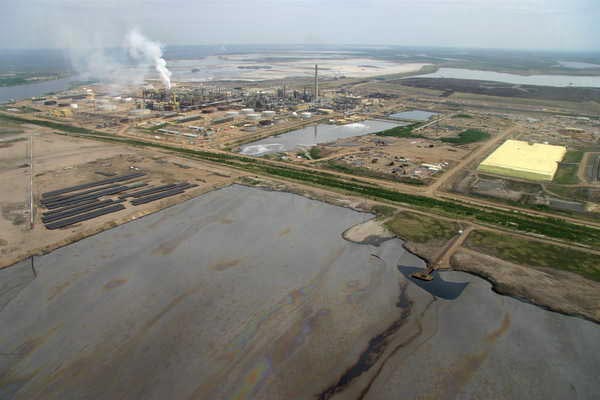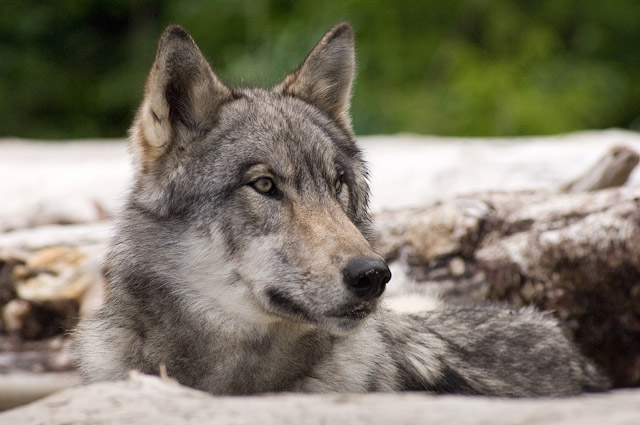|
| |
| 29. September 2011 |
Teersand-Abbau in Alberta droht die dortigen Karibuherden auszurotten.
Statt deren Lebensraum zu schützen sollen jetzt Tausende Wölfe
abgeschossen werden |
| |
| In einem 138.000 km² großen Gebiet in Alberta liegen unter dem borealen Wald ölhaltige Teersande, die sogenannten tar sands. Bei Erschließung aller Abbauflächen werden mindestens 4,3 Millionen Hektar dieses nördlichen Waldes, der unter anderem Lebensraum der dortigen Waldkaribus ist, zerstört werden. Bereits heute werden über 200 Millionen Liter Öl aus den Teersanden gewonnen, was 5 bis 10 Mal mehr Energie verschlingt als die konventionelle Ölförderung. Diese Ölförderung ist die klimaschädlichste weltweit. Das Öl soll zukünftig auch durch die geplante Pipeline nach Kitimat im Herzen des Great Bear Rainforest gepumpt werden, um es von dort aus mit Supertankern nach Asien transportieren zu können (Northern Gateway Pipeline-Projekt der Enbridge Corp.). Die Umweltzerstörungen im Norden von Alberta sind von apokalyptischem Ausmaß. Bilder des Pembina Instituts zeigen, was die Ölindustrie dort bereits angerichtet hat, um Kanada den Status einer neuen Ölsupermacht zu verleihen. |
| |
 |
Teersande-Tagebau nördlich von Fort McMurray, Alberta (Suncore Millennium Mine)
© David Dodge, The Pembina Institute |
| |
| Auf der Strecke bleiben neben vielen anderen Wildtieren auch die letzten kleinen Herden der Waldkaribus. Diese sind längst vom Aussterben bedroht, da ihr Lebensraum großflächig zerstört wurde. Das Überleben fast aller Herden in Alberta wird von offizieller Seite aus bereits als „äußerst unwahrscheinlich“ klassifiziert. Erst jetzt – fünf Minuten nach zwölf – legte Environment Canada bzw. die Kanadische Regierung den Entwurf eines Schutzplanes für die allerletzten Waldkaribus vor – mit erschreckenden Vorschlägen: Statt der unkontrollierten Expansion der Teersand-Abbauflächen Einhalt zu gebieten (was politisch unerwünscht ist) und den Lebensraum der Waldkaribus zu schützen, sollen lieber Tausende Wölfe zu deren Schutz abgeschossen werden. Heather Scoffield informierte in ihrem Artikel in „The Canadian Press“ vom 12. September (Federal recovery plan for caribou suggests thousands of wolves stand to die) die Öffentlichkeit, was der Schutzplan für die Karibus für die Wölfe Albertas bedeuten kann: „Thousands of wolves stand to be killed in Alberta as part of the federal government’s new plan to sustain caribou in the oilsands area, environmental researchers say. It’s a calculation that Environment Minister Peter Kent doesn’t contest, even though he wishes he could. ‚You are talking about very large numbers,’ Kent said in an interview. ‚Culling is an accepted if regrettable scientific practice and means of controlling populations and attempting to balance what civilization has developed. I’ve got to admit, it troubles me that that’s what is necessary to protect this species.’ … while the report does not dwell on using an extended and intensive wolf cull to protect fragile caribou populations, it’s clearly one of the few options left for the Alberta herds. It would be a key stop-gap measure while the natural habitat is slowly repaired over the coming decades – likely used in conjunction with other strategies such as allowing increased hunting of deer and moose, who share the caribou habitat. Environment Canada’s research shows that 100 wolves would need to die for every four caribou calves saved. While Kent would not go through the math to say how many wolves he thinks are at risk in total, he did not disagree with experts’ estimates. ‚It would be an astronomical effort. It would be thousands of wolves in the end. It’s not a very appealing option‘, said Stan Boutin, a caribou biologist at the University of Alberta.“ |
| |
 |
| Teersande-Abbaugebiet, Alberta © David Dodge, The Pembina Institute |
| |
| Forscher des Pembina Instituts schätzen, dass alle fünf Jahre etwa 6.000 Wölfe getötet werden müssten, wenn sie Zahlen für ein kleineres Karibuschutzprojekt im Gebiet des Litte Smoky River ihren Berechnungen zugrunde legen. Der kanadische Umweltminister Peter Kent verteidigt den geplanten Abschuss der Wölfe als notwendig: „There are very few alternatives. The alternatives for example to predator control is building vast fences and maintaining protection, which is economically just not feasible. It is difficult.“ In ihrem Artikel beschreibt Heather Scoffield das Dilemma, in dem das kanadische Umweltministerium jetzt steckt, weil es jahrzehntelang so gut wie nichts zum Schutz der Waldkaribus unternommen hat. „Much of the habitat in question overlaps with the oilsands region – although experts and the federal report alike don’t hold the oilpatch solely responsible for the destruction of the caribou habitat. Rather, they say it’s a culmination of decades, even centuries, of industrial development in the region that has upset the delicate balance caribou need to thrive. There are signs the private sector is looking for ways to be proactive on preventing further erosion. But even if the Alberta and federal governments could somehow persuade oil companies to foot the bill of penning caribou, the public may not welcome such an option, said Boutin. ‚It’s a direct trade-off, and society and everybody is going to have to make some real hard decisions there, because you cannot, over extensive areas, have both of those activities going on and preserve caribou unless you go to other drastic conservation efforts like predator control or fencing‘, he said. ‚The fencing issue comes down to: will society buy into what many consider creating a bit of a zoo?‘ Public acceptance of a massive and sustained wolf cull is likely to be a tough sell, Kent allows. But he points out that the public has accepted similar strategies elsewhere …“ |
| |
 |
| Teersande-Abbaugebiet, Alberta © David Dodge, The Pembina Institute |
| |
| Noch ist der Karibu-Schutzplan nur ein Entwurf, 60 Tage lang können Kommentare und Verbesserungsvorschläge abgegeben werden, danach wird er in Kraft treten. Für das Überleben der Karibus sieht es bei weiter ungebremster Lebensraumzerstörung durch die Ölindustrie nicht gut aus und die Wölfe Albertas werden wohl einen extrem hohen Blutzoll zahlen müssen. |
| Als Entgegnung auf den vorgelegten Karibu-Schutzplan schrieb auch Paul Paquet von der Raincoast Conservation Foundation einen Artikel, der zunächst am 17. September in „The Guardian“ erschienen ist und daraufhin in zahlreichen weiteren Zeitungen veröffentlicht wurde. Als Forscher, der unter anderem 40 Jahre lang das Leben der Wölfe erforscht hat, ergreift Paul Paquet Position für die Wölfe. Sein Artikel, der auch die politischen Hintergründe beleuchtet, ist so bedeutsam, dass er nachfolgend in voller Länge wiedergegeben ist. |
| |
| Paul Paquet, The Guardian, 17. September 2011 |
| Wolves fall prey to Canada’s rapacious tar sands business |
| On the pretext of protecting caribou, wolves are threatened with a cull. But the real „conservation“ is of oil industry profits |
| Wolves are routinely, baselessly and contemptuously blamed for the demise of everything from marmots to mountain caribou in western Canada. Given that attitude, we at Raincoast Conservation Foundation are appalled, though not surprised, by Canada’s proposed strategy to „recover“ dwindling populations of boreal forest caribou in northern Alberta’s tar sands territory. Essentially, the plan favours the destruction of wolves over any consequential protection, enhancement or expansion of caribou habitat. |
| Clearly, the caribou recovery strategy is not based on ecological principles or available science. Rather, it represents an ideology on the part of advocates for industrial exploitation of our environment, which subsumes all other principles to economic growth, always at the expense of ecological integrity. Owing to the breadth of the human niche, which continues to expand via technological progress, the human economy grows at the competitive exclusion of nonhuman species in the aggregate. The real cost of Alberta’s tar sands development, which includes the potential transport of oil by Northern Gateway and Keystone XL pipelines is being borne by wolves, caribou and other wild species. |
| Consistent with Canada’s now well-deserved reputation as an environmental laggard, the caribou recovery strategy evolved over several years and many politicised iterations, carefully massaged by government pen pushers and elected officials who did their very best to ignore and obscure the advice of consulting biologists and ecologists. So, the government should quit implying that the consultation approach provides a scientifically credible basis for decisions. Apparently, scientists can lead federal Environment Minister Peter Kent to information, but they cannot make him think. |
| Egged on by a rapacious oil industry, the federal government has chosen to scapegoat wolves for the decline of boreal caribou in a morally and scientifically bankrupt attempt to protect Canada’s industrial sacred cow: the tar sands. Yet, the ultimate reason why the caribou are on the way out is because multiple human disturbances – most pressingly, the tar sands development – have altered their habitat into a landscape that can no longer provide the food, cover and security they need. |
| The relentless destruction of boreal forest wilderness via tar sands development has conspired to deprive caribou of their life requisites while exposing them to levels of predation they did not evolve with and are incapable of adapting to. Consequently, caribou are on a long-term slide to extinction; not because of what wolves and other predators are doing but because of what humans have already done. |
| Controlling wolves by killing them or by the use of non-lethal sterilisation techniques is biologically unsound as a long-term method for reducing wolf populations and protecting hoofed animals (ungulates) from predation. Lethal control has a well documented failed record of success as a means of depressing numbers of wolves over time. Killing wolves indiscriminately at levels sufficient to suppress populations disrupts pack social structure and upsets the stability of established territories, allowing more wolves to breed while promoting the immigration of wolves from nearby populations. |
| At the broadest level, the caribou strategy favours human selfishness at the expense of other species. Implicit is the idea that commercial enterprise is being purchased by the subversion of the natural world, with one set of ethical principles being applied to humans and another to the rest of nature. The strategy panders to the ecologically destructive wants of society by sacrificing the most basic needs of caribou. In doing so, it blatantly contradicts the lesson Aldo Leopold taught us so well: the basis of sound conservation is not merely pragmatic it; is also ethical. |
| Simply, the caribou strategy is not commensurate with the threats to the species’ survival. What is desperately needed is a caribou strategy designed to solve the problem faster than it is being created. Protecting limited habitat for caribou while killing thousands of wolves as the exploitation of the tar sands continues to expand will not accomplish this goal. Against scientific counsel otherwise, though, politicians have decided that industrial activities have primacy over the conservation needs of endangered caribou (and frankly, all things living). |
| Tar sands cheerleaders try hard to convince Canadians that we can become an „energy superpower“while maintaining our country’s environment. They are, of course, wrong. Thousands of wolves will be just some of the causalities along the way. Minister Kent and his successors will find more opportunity to feign empathy as Canadians also bid farewell to populations of birds, amphibians and other mammals, including caribou, that will be lost as collateral damage from tar sands development. How much of our country’s irreplaceable natural legacy will Canadians allow to be sacrificed at the altar of oil industry greed? |
| |
 |
| Wolf (Canis lupus) zwischen Treibholz an einem Seeufer © Klaus Pommerenke |
| |
 zurück zurück |
|
|




